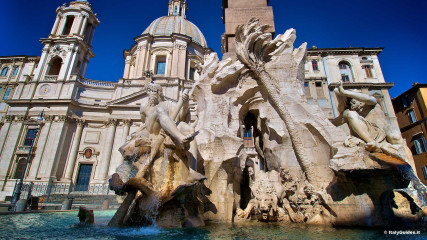From the shadows of the ancient, winding streets of the historic center you suddenly come upon the breathtaking magnificence of Piazza Navona, born as a place of spectacle and still today a spectacular open air show; an architectural miracle in the heart of the Eternal City, filled with masterpieces in perfect harmony with each other.
Your gaze is immediately drawn to the imposing Fountain of the Four Rivers in the center of the piazza, dominating the scene with its powerful presence and figures that seem to come alive from the sound of the rushing streams of the water.
This piazza, which displays the genius of Bernini and Borromini, is one of the finest Baroque Masterpiece in papal Rome. Its harmony and colors, combined with its elegance, give it a charm that is enhanced by the surprising contrast of architecturally sober houses alternating with a number of monumental Buildings.
The unusual shape of the piazza isn't a baroque affectation but precisely follows the ancient perimeter of the Stadium of Domitian that once stood on this spot. The stadium was a grand edifice ordered by the emperor in the first century BCE; it had a rectangular shape with rounded short sides, was completely covered in white marble and could hold up to 30,000 spectators!
As opposed to other Roman structures built to house spectacles, such as Circus Maximus or the Colosseum, the stadium of Domitian didn't offer chariot races or gladiator fights: here were played the "Agones", the games in honor of Jove, and the athletes arrived directly from Greece for the sporting matches where even little girls challenged each other in races. The name of the piazza is derived precisely from the Greek term "Agone"--contest--which in the Middle Ages became "in Agone" and finally "Navona".
As in almost all the places destined for fun and games in ancient Rome, the stadium was surrounded by taverns and lupanari (ancient houses of ill repute). The prostitutes would snare customers by exhibiting paintings illustrating their specialties. Female slaves, on the other hand, were shown naked to possible buyers.
This was the fate of Sant'Agnese, a Christian virgin: legend has it that she was protected from indiscrete eyes thanks to the sudden miraculous growth of her hair and it is to her and the spot where she was martyred that the church designed by Borromini stands.
In the Middle Ages, the piazza maintained its identity as an entertainment center and for decades was continuously used for horse races, bull fights and somewhat less noble battles than those of antiquity, some of them resembling a free-for-all more than anything else!
The most spectacular show of all continued to be the so-called "lake”: every Saturday in August the drains to the sewer system were blocked and the water from the fountains was allowed to overflow until it filled the entire piazza: this was partly to fight the summer heat but the main reason was to be able to re-enact famous naval battles.
According to accounts from the period, there were serenades, fireworks and carriages circulating around the lake, looking like enormous horse-drawn gondolas and accompanied by mischievous children. This joyous tradition continued for almost two centuries until Pope Pius IX suspended it for reasons of “public order”.
Piazza Navona came back to life in the second half of the 15th century when the market that had been held until then at the foot of the Capitoline hill was moved there.
The final destiny of the piazza however was decided by Giovanni Battista Pamphilj, who became pope in 1644 with the name Innocent X.
Soon after being elected Pope, Innocent X (1644-55) decided to embellish the piazza in honor of his family, the Pamphilj, just as Urban VIII had revamped part of Quirinal hill to glorify the Berberini family. With this in mind, he had his family palace and the church of Sant'Agnese in Agone rebuilt, ordered the restoration of the two fountains (Fountain of the Moor and Fountain of Neptune) that Gregory XIII (1572-85) had installed at either end of the piazza, and commissioned the colossal Fontana Dei Quattro Fiumi in center.
The people of Rome, forced to pay new taxes for the excessive embellishment of the piazza, reached the boiling point and laid siege to it, forcing the pope to surround it with armed guards.
In the 19th century the piazza was paved with "sampietrini", the typical basalt paving blocks of the center of Rome. The new convex sidewalk in the middle unfortunately ended forever the possibility of any future enactments of the "lake".
At the end of piazza Navona, there are two fountains by Giacomo della Porta: the Fountain of the Moor and the fountain of Neptune.
On the other end, the fountain of Neptune, originally called the "fìountain of the kettle makers", remained unfinished for a long time until a few marine deities were added along with the statue of the god of the sea battling an octopus.
Today life in the piazza revolves around the open-air-cafés and the seasonal fairs. The most popular is the one held in December where toys and crib figures are sold and the Feast of Epiphany. In italian popular folklore during the Feast of Epiphany on January 6th, the Befana (an old lady who brings sweets and sugar charcoal) visits all the children and tradition wants her to arrive here in Piazza Navona.
Piazza Navona is one of the Roman's most treasured piazzas; here, in centuries past, acrobats and jugglers performed and even today, it's still lively with painters and street performers that put on their shows for tourists and passersby, new spectators of that life that's always flowed though the piazza with movement and joy.
















